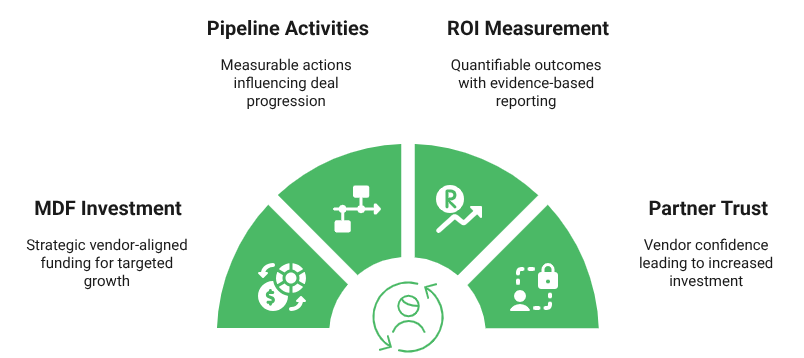Author: Steve Caunce
Date: August 2025

Authors Perspective
In my 20+ years working across APAC’s IT channel, I’ve seen firsthand how often MDF becomes a wasted opportunity. As a former Head of Marketing and Vendor Alliances inside large and fast-scaling providers, I’ve been on both sides of the partner fence. I’ve felt the pressure to show ROI, navigated convoluted claim processes, and experienced the frustration of losing mindshare because we didn’t report impact effectively.
What changed? We stopped viewing MDF as a ‘campaign fund’ and started treating it like capital investment. Quarterly rhythms, co-branded GTM strategies, tight reporting, and structured partner engagement flipped the narrative. This blog explores what the best are doing differently – and how you can apply it.
By Steven Caunce, Senior Marketing Consultant
Outline
When operationalised properly, MDF becomes a growth engine – not just budget relief. The most effective providers use MDF to fuel recurring pipeline, secure preferred partner status, and drive vendor reinvestment.
- Strategic use of Market Development Funds (MDF) drives long-term revenue growth and vendor loyalty.
- High-performing IT Services providers treat MDF as an operational discipline, not a one-off activity.
- Quarterly business reviews (QBRs), proof of ROI, and consistent execution lead to repeat funding.
- Real-world examples show MDF improving partner visibility, renewal rates, and co-investment.
- A flywheel of MDF → Pipeline → ROI → Vendor Trust helps firms build competitive advantage.
Introduction
In my 20+ years working across APAC’s IT channel, I’ve seen firsthand how often MDF becomes a wasted opportunity. As a former Head of Marketing and Vendor Alliances inside large and fast-scaling providers, I’ve been on both sides of the partner fence. I’ve felt the pressure to show ROI, navigated convoluted claim processes, and experienced the frustration of losing mindshare because we didn’t report impact effectively.
What changed? We stopped viewing MDF as a ‘campaign fund’ and started treating it like capital investment. Quarterly rhythms, co-branded GTM strategies, tight reporting, and structured partner engagement flipped the narrative. This blog explores what the best are doing differently – and how you can apply it.
– Steven Caunce, Partner Marketing Strategist, Digital Pivot
Outline
- Why treating MDF as “one-and-done” fails
- Building a growth rhythm: the QBR approach
- Case-in-point: MDF → Partner preference → Renewal uplift
- Proving ROI = Driving reuse
- Creating your MDF growth flywheel
Why Treating MDF as “One-and-Done” Fails
Many IT and consulting firms treat MDF like a sugar hit: a short-term energy boost that gets used up quickly, then forgotten. However this reactive approach leads to:
- No long-term pipeline visibility
- Poor claim documentation
- Loss of vendor trust
- Little to no reuse of funds next quarter
Worse still, when results aren’t documented or shared back, it reinforces the vendor perception that co-investment isn’t delivering. The outcome? Less funding next time, regardless of potential.
Building a Growth Rhythm: The QBR Approach
Top-performing partners don’t treat MDF as a quarterly rush. They bake it into their operating cadence. The cornerstone of this approach is the Quarterly Business Review (QBR). Here’s how leading firms structure it:
1. Campaign Recap
- What activity ran
- Target outcomes vs actuals
- Key wins and learning
2. ROI Summary
- Pipeline created
- Influence on closed deals
- Vendor visibility uplift
3. Strategic Re-alignment
- Upcoming GTM priorities
- Product launches, territory plans
- Where MDF can be reapplied
4. Action Plan
- Timeline for next submission
- Roles, creative themes, and metrics
- Claim lodgement schedule
This rhythm creates accountability, builds trust, and most importantly, shows the vendor you’re not just spending – you’re investing and reporting like a partner that takes growth seriously.
Case-in-Point: MDF → Partner Preference → Renewal Uplift
One Digital Pivot client – an ANZ-based cloud integrator with 150 staff – implemented a structured MDF growth loop across three key vendors.
Here’s what changed over two quarters:
- Pipeline Influence: $1.2M in net-new opportunities tagged to MDF-funded campaigns
- Claim Cycle Efficiency: Claims submitted within 5 working days post-campaign (vs 30+ previously)
- Vendor Preference: Shifted from “tier 2” to “preferred partner” within 6 months
- Renewal Uplift: Saw a 15% increase in renewal rates for clients touched by co-funded content and events
This was not a resource-heavy transformation. It was a mindset shift – from MDF as a spend, to MDF as a flywheel for growth.
Proving ROI = Driving Reuse
Vendors are increasingly data-driven in how they allocate co-marketing funds. The implication is clear: no proof = no renewal.
To avoid this, you must ensure:
- Attribution data is captured early: UTM parameters, landing pages, CRM tagging
- Outcome data is reported cleanly: Leads, meetings, influenced pipeline
- ROI is clearly benchmarked: $1 invested → $X pipeline created
This isn’t just good hygiene. It becomes your strongest lever for reapplying and winning more MDF next quarter. In the eyes of the vendor, your ability to deliver pipeline makes you low-risk and high-impact.
Creating Your MDF Growth Flywheel

At Digital Pivot, we’ve observed a consistent pattern among top performers. They build an MDF flywheel with four key phases:
1. MDF – Targeted, vendor-aligned investment – not scattered tactical spend
2. Pipeline – Activities designed to create measurable influence on deals
3. ROI – Quantifiable outcomes tied to campaign, reported back with evidence
4. Partner Trust – Growth inVendor confidence → More investment → Cycle repeats
Each rotation strengthens your vendor relationships, improves internal sales and marketing alignment, and helps turn MDF from a one-off boost into a predictable source of growth.
Ready to Turn MDF Into Measurable Growth?
How do I get started with MDF Maximiser?
Contact us today to discuss how MDF Maximiser can transform partner growth in your business.
About the Author

Steve Caunce is a B2B marketing strategist with over 20 years of experience driving growth through channel partnerships, co-marketing programmes, and go-to-market innovation. At Digital Pivot, he helps IT services and consulting firms unlock the full value of their vendor relationships by transforming Market Development Funds into measurable pipeline outcomes. Steven is passionate about bridging the gap between strategy and execution, and making partner marketing work harder in today’s ROI-driven environment.
Connect with Steve on LinkedIn
FAQs on how to turn MDF into a Competitive Advantage for IT Services and Consulting:
- Why 60% of MDF Goes Unused Every Quarter – And What That’s Really Costing You
- The Silent Pipeline Killer: When MDF Is Disconnected From Sales
- Choosing the right MDF Partner: What to Look For
- From Chaos to Clarity – Operationalising MDF for Growth
- Turning MDF Into a Competitive Advantage for IT Services
Ready to turn MDF into a growth engine?
Let’s work together to make your vendor-funded campaigns deliver more than just compliance.
- ✅ Download a one page overview of MDF Maximiser
- ✅ Book a Free 30-Min Strategy Call
- ✅ We will help you Build a Plan, validate your ROI. Get Funded. Get Results.

